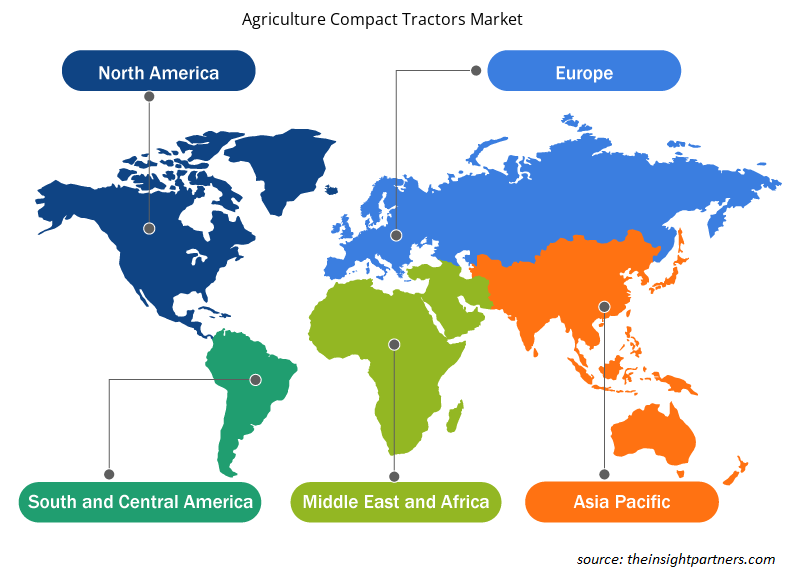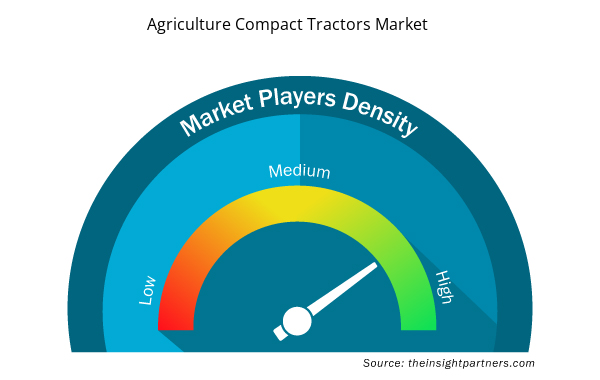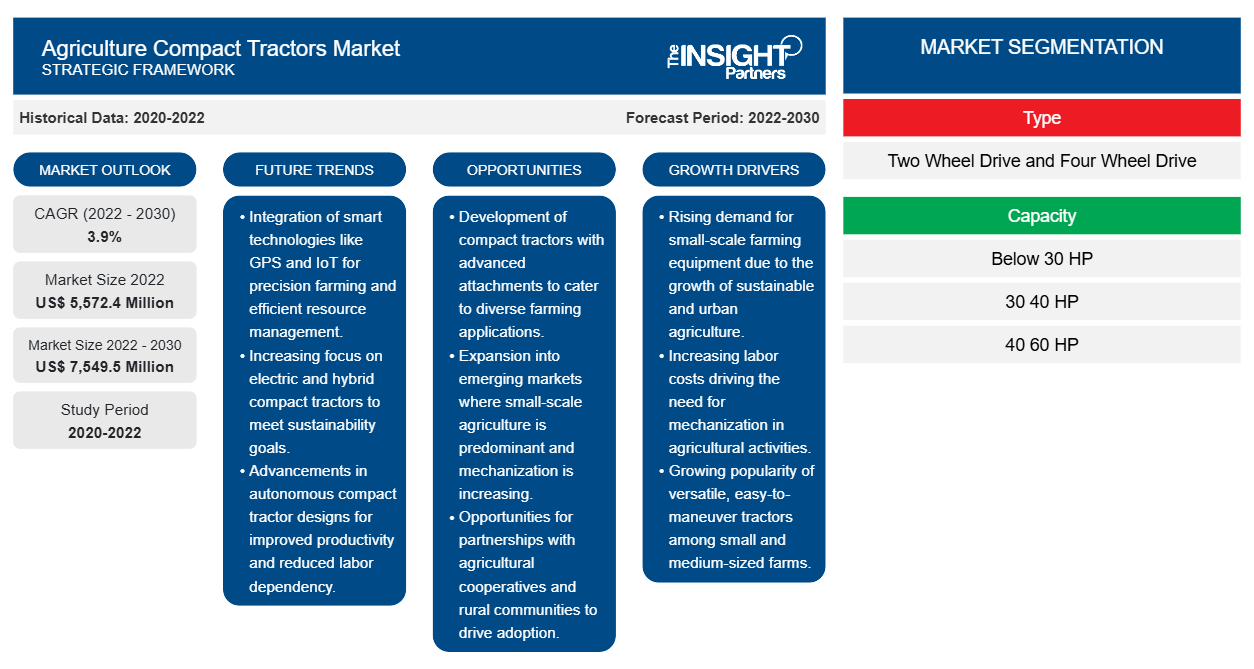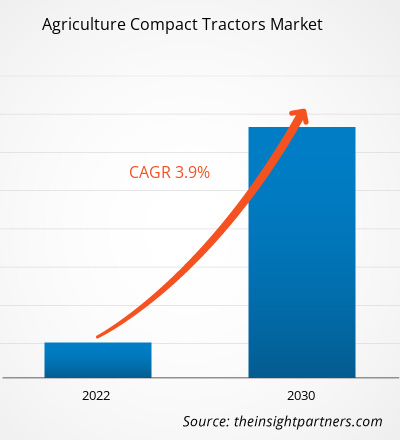[Rapport de recherche] La taille du marché des tracteurs compacts agricoles devrait passer de 5 572,4 millions USD en 2022 à 7 549,5 millions USD d'ici 2030 ; le marché devrait enregistrer un TCAC de 3,9 % de 2022 à 2030.
Point de vue de l'analyste :
Le secteur agricole en croissance continue, ainsi qu'une préférence croissante pour les équipements modernes, stimulent la croissance du marché mondial des tracteurs agricoles compacts . La demande de nourriture augmente avec une population en constante augmentation. Selon les récentes prévisions des Nations Unies, la population mondiale devrait atteindre 8,5 milliards d'ici 2030 et 9,7 milliards d'ici 2050. En conséquence, la demande de produits agricoles augmente rapidement, ce qui oblige les agriculteurs à améliorer les rendements de leurs exploitations. Par conséquent, l'échelle croissante des activités agricoles propulse la demande de tracteurs agricoles compacts.
En janvier 2024, LS Mtron Co., un fabricant sud-coréen de machines lourdes et de composants électroniques, a lancé la nouvelle série de petits tracteurs MT2·MT2E en Amérique du Nord. Les deux modèles de cette série, le MT2 haut de gamme et le MT2E économique, sont conçus pour améliorer le confort d'utilisation dans les endroits restreints et conviennent à l'agriculture à petite échelle. Cette gamme de produits a été conçue pour divers travaux, notamment une navette facile à utiliser pour des opérations avant et arrière en douceur, et des pédales doubles adaptées au transfert de terre ou de gravier. De telles activités de développement de produits par les fabricants de tracteurs agricoles compacts alimentent la croissance du marché des tracteurs agricoles compacts.
Aperçu du marché :
Les tracteurs compacts, généralement appelés tracteurs utilitaires compacts, sont principalement utilisés pour les petites activités agricoles telles que le labourage, la tonte, la plantation, le labourage et le transport. Ils sont plus petits en taille et en capacité, et plus avantageux pour les petites exploitations, les vergers et les vergers de noix, les vignobles, les jardins et les pelouses. Les tracteurs compacts consomment moins de carburant et nécessitent peu d'entretien, ce qui se traduit par de faibles coûts d'exploitation.
L'Asie-Pacifique domine le marché des tracteurs agricoles compacts en raison de l'ampleur des activités agricoles dans des pays comme la Chine et l'Inde. Cependant, l'Amérique du Nord et l'Europe devraient enregistrer de fortes valeurs de TCAC au cours de la période de prévision. Les États-Unis sont l'un des principaux producteurs de noix et de fruits. Selon les données publiées par le ministère américain de l'Agriculture en 2022, les petites exploitations familiales représentaient 88 % du total des exploitations agricoles aux États-Unis. Ainsi, la présence d'un grand nombre de petites exploitations aux États-Unis est un facteur clé qui profite au marché des tracteurs agricoles compacts dans ce pays.
Personnalisez ce rapport en fonction de vos besoins
Vous bénéficierez d'une personnalisation gratuite de n'importe quel rapport, y compris de certaines parties de ce rapport, d'une analyse au niveau des pays, d'un pack de données Excel, ainsi que de superbes offres et réductions pour les start-ups et les universités.
- Obtenez les principales tendances clés du marché de ce rapport.Cet échantillon GRATUIT comprendra une analyse de données, allant des tendances du marché aux estimations et prévisions.
Moteur du marché :
Initiatives gouvernementales pour soutenir les petits exploitants agricoles
Les politiques gouvernementales et les initiatives de soutien telles que le financement augmentent le nombre de petites exploitations agricoles dans différents pays. Par exemple, le ministère américain de l'Agriculture propose un programme de microcrédit aux petits agriculteurs et aux agriculteurs débutants qui leur permet d'obtenir jusqu'à 35 000 USD de prêts grâce à de simples demandes. De plus, en 2023, le gouvernement du Guyana a annoncé une initiative dans le cadre de son programme National Pathway for Food Systems. Dans le cadre de ce projet, des fournitures d'intrants agricoles et une subvention ponctuelle en espèces ont été fournies aux petits exploitants agricoles et aux participants à des programmes continus d'autonomisation socio-économique dans tout le pays. De telles initiatives gouvernementales permettent aux petits agriculteurs d'adopter des équipements agricoles, notamment des tracteurs compacts. De plus, ces programmes et initiatives créent un environnement propice aux petites exploitations agricoles dans les pays en développement et développés, ce qui se traduit en fin de compte par l'expansion de la taille du marché des tracteurs compacts agricoles.
Analyse segmentaire :
L'analyse du marché des tracteurs agricoles compacts a été réalisée en prenant en compte les segments suivants : type, capacité et application. Sur la base de la capacité, le marché est segmenté en moins de 30 CV, 30 CV-40 CV et 40 CV-60 CV. Les segments 40 CV-60 CV et 30 CV-40 CV représentent collectivement plus de 50 % de la part de marché des tracteurs agricoles compacts. Ces tracteurs conviennent aux exploitations de taille moyenne pour des tâches telles que le labour, le labourage, la plantation et la récolte. Par exemple, Farmtrac a lancé son nouveau tracteur Farmtrac 60 Powermaxx en 2024. Ce tracteur est doté d'un moteur de 55 CV et offre plusieurs fonctionnalités.
Analyse régionale :
La portée géographique du rapport sur le marché des tracteurs compacts agricoles comprend l’Amérique du Nord (États-Unis, Canada et Mexique), l’Europe (Espagne, Royaume-Uni, Allemagne, France, Italie et reste de l’Europe), l’Asie-Pacifique (Corée du Sud, Chine, Inde, Japon, Australie et reste de l’Asie-Pacifique), le Moyen-Orient et l’Afrique (Afrique du Sud, Arabie saoudite, Émirats arabes unis et reste du Moyen-Orient et de l’Afrique) et l’Amérique du Sud et centrale (Brésil, Argentine et reste de l’Amérique du Sud et centrale). L’Asie-Pacifique représentait la plus grande part de marché des tracteurs compacts agricoles en 2022.
Le marché nord-américain des tracteurs agricoles compacts est segmenté entre les États-Unis, le Canada et le Mexique. Le secteur agricole en Amérique du Nord, en particulier dans des pays comme les États-Unis, le Canada et le Mexique, stimule principalement la demande de tracteurs agricoles compacts. L'expansion du secteur agricole et les développements continus de produits continueront de stimuler le marché dans cette région à l'avenir. Selon les données publiées par le ministère américain de l'Agriculture en 2021, le secteur agricole a contribué à hauteur d'environ 1 264 milliards de dollars américains au PIB américain en 2021, soit 5,4 % du PIB national. Selon les données publiées par le gouvernement canadien en 2022, le secteur agricole et agroalimentaire apporte une contribution significative à l'économie canadienne. Les ventes canadiennes de produits agricoles, en croissance à un taux annuel de 5,6 %, ont totalisé 87,7 milliards de dollars américains en 2022. Le nombre croissant de petites exploitations agricoles entraîne une demande accrue de tracteurs compacts, ce qui offre de nouvelles perspectives de croissance aux fournisseurs. En outre, de nombreux acteurs clés aux États-Unis se concentrent désormais sur le développement de tracteurs compacts entièrement automatisés, et ces développements devraient apporter de nouvelles tendances au marché des tracteurs compacts agricoles en Amérique du Nord dans les années à venir.
Aperçu régional du marché des tracteurs compacts agricoles
Les tendances et facteurs régionaux influençant le marché des tracteurs compacts agricoles tout au long de la période de prévision ont été expliqués en détail par les analystes d’Insight Partners. Cette section traite également des segments et de la géographie du marché des tracteurs compacts agricoles en Amérique du Nord, en Europe, en Asie-Pacifique, au Moyen-Orient et en Afrique, ainsi qu’en Amérique du Sud et en Amérique centrale.

- Obtenez les données régionales spécifiques au marché des tracteurs compacts agricoles
Portée du rapport sur le marché des tracteurs compacts agricoles
| Attribut de rapport | Détails |
|---|---|
| Taille du marché en 2022 | 5 572,4 millions de dollars américains |
| Taille du marché d'ici 2030 | 7 549,5 millions de dollars américains |
| Taux de croissance annuel moyen mondial (2022-2030) | 3,9% |
| Données historiques | 2020-2022 |
| Période de prévision | 2022-2030 |
| Segments couverts | Par type
|
| Régions et pays couverts | Amérique du Nord
|
| Leaders du marché et profils d'entreprises clés |
|
Densité des acteurs du marché des tracteurs compacts agricoles : comprendre son impact sur la dynamique commerciale
Le marché des tracteurs compacts agricoles connaît une croissance rapide, tirée par la demande croissante des utilisateurs finaux en raison de facteurs tels que l'évolution des préférences des consommateurs, les avancées technologiques et une plus grande sensibilisation aux avantages du produit. À mesure que la demande augmente, les entreprises élargissent leurs offres, innovent pour répondre aux besoins des consommateurs et capitalisent sur les tendances émergentes, ce qui alimente davantage la croissance du marché.
La densité des acteurs du marché fait référence à la répartition des entreprises ou des sociétés opérant sur un marché ou un secteur particulier. Elle indique le nombre de concurrents (acteurs du marché) présents sur un marché donné par rapport à sa taille ou à sa valeur marchande totale.
Les principales entreprises opérant sur le marché des tracteurs compacts agricoles sont :
- Tracteur YANMAR
- Mahindra
- SOCIÉTÉ TYM
- Solelectrac
- John Deere
Avis de non-responsabilité : les sociétés répertoriées ci-dessus ne sont pas classées dans un ordre particulier.

- Obtenez un aperçu des principaux acteurs du marché des tracteurs compacts agricoles
Analyse des acteurs clés :
AGCO GmbH, Yamaha Tractors, Solis, Bobcat Company, Mahindra Tractors, Kubota, John Deere, Massey Ferguson et New Holland font partie des principaux acteurs présentés dans le rapport sur le marché des tracteurs compacts agricoles. Outre ces acteurs, plusieurs autres entreprises importantes ont été étudiées et analysées au cours de cette étude pour obtenir un aperçu global du marché mondial des tracteurs compacts utilitaires.
Développements récents :
Les stratégies inorganiques et organiques telles que les fusions et acquisitions sont largement adoptées par les entreprises du marché mondial des tracteurs agricoles compacts. Quelques développements récents des principaux acteurs du marché des tracteurs agricoles compacts, selon les communiqués de presse, sont énumérés ci-dessous :
Année | Nouvelles | Région |
Août 2023 | Case IH a lancé ses nouveaux tracteurs Farmall Subcompact 25SC. Ce nouveau modèle est le plus petit tracteur de la gamme Case IH. Le nouveau tracteur est doté d'une gamme de moteurs allant de 25 à 115 ch. | Asie-Pacifique |
Février 2023 | Bobcat a présenté une nouvelle gamme de tracteurs compacts, baptisée séries 1000, 2000 et 4000. La série comprend neuf modèles de tracteurs compacts qui se différencient en fonction de la puissance du moteur. Ces tracteurs ont une plage de puissance comprise entre 25 et 85 CV. | Europe |
- Analyse historique (2 ans), année de base, prévision (7 ans) avec TCAC
- Analyse PEST et SWO
- Taille du marché Valeur / Volume - Mondial, Régional, Pays
- Industrie et paysage concurrentiel
- Ensemble de données Excel



Report Coverage
Revenue forecast, Company Analysis, Industry landscape, Growth factors, and Trends

Segment Covered
This text is related
to segments covered.

Regional Scope
North America, Europe, Asia Pacific, Middle East & Africa, South & Central America

Country Scope
This text is related
to country scope.
Questions fréquemment posées
Continuous adoption of electric vehicles owing to increased focus on sustainability is one of the trends that is expected to drive the demand of the electric agriculture compact tractors market.
AGCO GmbH, Yamaha Tractors, Solis, Bobcat Company, Mahindra Tractors, Kubota, John Deere, Massey Ferguson, and New Holland are the key market players operating in the global agriculture compact tractors market.
Regions such as Europe, North America and Asia-Pacific will boost the growth of the agriculture compact tractors market during the forecast period. This growth is owing to the rise in investment for the adoption of the modern agriculture equipment and vineyards in the regions.
Many compact tractor manufacturers are focusing on developing fully automated compact tractors. Such development is projected to generate lucrative opportunities for the agriculture compact tractors market during the forecast period.
High customization options and low cost of compact tractors are a few of the factors contributing to the expansion of the agriculture compact tractors market size. Farming requires a wide range of agricultural equipment, and tractors form an unintegral part of this set of equipment. Purchasing various farm equipment can be expensive, whereas low prices of a small tractor provide some relief to agriculturists and farm owners. Lower price is especially a primary factor driving the adoption of agriculture compact tractors in in agriculture-dominating economies such as China and India, which are home to numerous small and low-margin farmers.
Trends and growth analysis reports related to Manufacturing and Construction : READ MORE..
The List of Companies - Agriculture Compact Tractors Market
- YANMAR Tractor
- Mahindra
- TYM CORPORATION
- Solectrac
- John Deere
- AGCO GmbH
- Bobcat Company
- New Hollland
- Massey Ferguson
- TAFE
- Jinma Tractor
- LANSU
The Insight Partners performs research in 4 major stages: Data Collection & Secondary Research, Primary Research, Data Analysis and Data Triangulation & Final Review.
- Data Collection and Secondary Research:
As a market research and consulting firm operating from a decade, we have published and advised several client across the globe. First step for any study will start with an assessment of currently available data and insights from existing reports. Further, historical and current market information is collected from Investor Presentations, Annual Reports, SEC Filings, etc., and other information related to company’s performance and market positioning are gathered from Paid Databases (Factiva, Hoovers, and Reuters) and various other publications available in public domain.
Several associations trade associates, technical forums, institutes, societies and organization are accessed to gain technical as well as market related insights through their publications such as research papers, blogs and press releases related to the studies are referred to get cues about the market. Further, white papers, journals, magazines, and other news articles published in last 3 years are scrutinized and analyzed to understand the current market trends.
- Primary Research:
The primarily interview analysis comprise of data obtained from industry participants interview and answers to survey questions gathered by in-house primary team.
For primary research, interviews are conducted with industry experts/CEOs/Marketing Managers/VPs/Subject Matter Experts from both demand and supply side to get a 360-degree view of the market. The primary team conducts several interviews based on the complexity of the markets to understand the various market trends and dynamics which makes research more credible and precise.
A typical research interview fulfils the following functions:
- Provides first-hand information on the market size, market trends, growth trends, competitive landscape, and outlook
- Validates and strengthens in-house secondary research findings
- Develops the analysis team’s expertise and market understanding
Primary research involves email interactions and telephone interviews for each market, category, segment, and sub-segment across geographies. The participants who typically take part in such a process include, but are not limited to:
- Industry participants: VPs, business development managers, market intelligence managers and national sales managers
- Outside experts: Valuation experts, research analysts and key opinion leaders specializing in the electronics and semiconductor industry.
Below is the breakup of our primary respondents by company, designation, and region:

Once we receive the confirmation from primary research sources or primary respondents, we finalize the base year market estimation and forecast the data as per the macroeconomic and microeconomic factors assessed during data collection.
- Data Analysis:
Once data is validated through both secondary as well as primary respondents, we finalize the market estimations by hypothesis formulation and factor analysis at regional and country level.
- Macro-Economic Factor Analysis:
We analyse macroeconomic indicators such the gross domestic product (GDP), increase in the demand for goods and services across industries, technological advancement, regional economic growth, governmental policies, the influence of COVID-19, PEST analysis, and other aspects. This analysis aids in setting benchmarks for various nations/regions and approximating market splits. Additionally, the general trend of the aforementioned components aid in determining the market's development possibilities.
- Country Level Data:
Various factors that are especially aligned to the country are taken into account to determine the market size for a certain area and country, including the presence of vendors, such as headquarters and offices, the country's GDP, demand patterns, and industry growth. To comprehend the market dynamics for the nation, a number of growth variables, inhibitors, application areas, and current market trends are researched. The aforementioned elements aid in determining the country's overall market's growth potential.
- Company Profile:
The “Table of Contents” is formulated by listing and analyzing more than 25 - 30 companies operating in the market ecosystem across geographies. However, we profile only 10 companies as a standard practice in our syndicate reports. These 10 companies comprise leading, emerging, and regional players. Nonetheless, our analysis is not restricted to the 10 listed companies, we also analyze other companies present in the market to develop a holistic view and understand the prevailing trends. The “Company Profiles” section in the report covers key facts, business description, products & services, financial information, SWOT analysis, and key developments. The financial information presented is extracted from the annual reports and official documents of the publicly listed companies. Upon collecting the information for the sections of respective companies, we verify them via various primary sources and then compile the data in respective company profiles. The company level information helps us in deriving the base number as well as in forecasting the market size.
- Developing Base Number:
Aggregation of sales statistics (2020-2022) and macro-economic factor, and other secondary and primary research insights are utilized to arrive at base number and related market shares for 2022. The data gaps are identified in this step and relevant market data is analyzed, collected from paid primary interviews or databases. On finalizing the base year market size, forecasts are developed on the basis of macro-economic, industry and market growth factors and company level analysis.
- Data Triangulation and Final Review:
The market findings and base year market size calculations are validated from supply as well as demand side. Demand side validations are based on macro-economic factor analysis and benchmarks for respective regions and countries. In case of supply side validations, revenues of major companies are estimated (in case not available) based on industry benchmark, approximate number of employees, product portfolio, and primary interviews revenues are gathered. Further revenue from target product/service segment is assessed to avoid overshooting of market statistics. In case of heavy deviations between supply and demand side values, all thes steps are repeated to achieve synchronization.
We follow an iterative model, wherein we share our research findings with Subject Matter Experts (SME’s) and Key Opinion Leaders (KOLs) until consensus view of the market is not formulated – this model negates any drastic deviation in the opinions of experts. Only validated and universally acceptable research findings are quoted in our reports.
We have important check points that we use to validate our research findings – which we call – data triangulation, where we validate the information, we generate from secondary sources with primary interviews and then we re-validate with our internal data bases and Subject matter experts. This comprehensive model enables us to deliver high quality, reliable data in shortest possible time.


 Obtenez un échantillon gratuit pour ce rapport
Obtenez un échantillon gratuit pour ce rapport